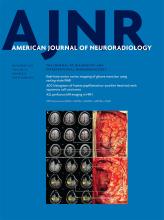Index by author
Prieto, R.
- Adult BrainYou have accessTopographic Diagnosis of Craniopharyngiomas: The Accuracy of MRI Findings Observed on Conventional T1 and T2 ImagesR. Prieto, J.M. Pascual and L. BarriosAmerican Journal of Neuroradiology November 2017, 38 (11) 2073-2080; DOI: https://doi.org/10.3174/ajnr.A5361
Pritz, M.B.
- EDITOR'S CHOICENeurointerventionOpen AccessAngioarchitectures and Hemodynamic Characteristics of Posterior Communicating Artery Aneurysms and Their Association with Rupture StatusB.J. Chung, R. Doddasomayajula, F. Mut, F. Detmer, M.B. Pritz, F. Hamzei-Sichani, W. Brinjikji, D.F. Kallmes, C.M. Jimenez, C.M. Putman and J.R. CebralAmerican Journal of Neuroradiology November 2017, 38 (11) 2111-2118; DOI: https://doi.org/10.3174/ajnr.A5358
The authors studied 313 posterior communicating artery aneurysms (145 ruptured, 168 unruptured) with image-based computational fluid dynamics. Aneurysms were classified into different angioarchitecture types depending on the location of the aneurysm with respect to parent artery bifurcation. Ruptured aneurysms had higher, more concentrated, and more oscillatory wall shear stress distributions; stronger and more concentrated inflow jets; and more complex and unstable flow patterns compared with unruptured aneurysms. They conclude that high-flow intrasaccular hemodynamic characteristics, commonly found in bifurcation-type angioarchitectures, are associated with the posterior communicating artery aneurysm rupture status.
Purcell, Y.M.
- Head and Neck ImagingYou have accessThe Diagnostic Accuracy of Contrast-Enhanced CT of the Neck for the Investigation of SialolithiasisY.M. Purcell, R.G. Kavanagh, A.M. Cahalane, A.G. Carroll, S.G. Khoo and R.P. KilleenAmerican Journal of Neuroradiology November 2017, 38 (11) 2161-2166; DOI: https://doi.org/10.3174/ajnr.A5353
Pusztaszeri, M.
- FELLOWS' JOURNAL CLUBHead and Neck ImagingOpen AccessApparent Diffusion Coefficient Histograms of Human Papillomavirus–Positive and Human Papillomavirus–Negative Head and Neck Squamous Cell Carcinoma: Assessment of Tumor Heterogeneity and Comparison with HistopathologyT. de Perrot, V. Lenoir, M. Domingo Ayllón, N. Dulguerov, M. Pusztaszeri and M. BeckerAmerican Journal of Neuroradiology November 2017, 38 (11) 2153-2160; DOI: https://doi.org/10.3174/ajnr.A5370
One hundred five consecutive patients with primary oropharyngeal and oral cavity head and neck squamous cell carcinoma underwent MR imaging with anatomic and DWI sequences. The collected tumor voxels from the contoured ROIs provided histograms from which position, dispersion, and form parameters were computed. Histogram data were correlated with histopathology, p16-immunohistochemistry, and polymerase chain reaction for human papillomavirus DNA. Diffusion phenotypes of human papillomavirus–positive and human papillomavirus–negative head and neck squamous cell carcinomas showed significant differences, which reflect their distinct degree of tumor heterogeneity.
Putman, C.M.
- EDITOR'S CHOICENeurointerventionOpen AccessAngioarchitectures and Hemodynamic Characteristics of Posterior Communicating Artery Aneurysms and Their Association with Rupture StatusB.J. Chung, R. Doddasomayajula, F. Mut, F. Detmer, M.B. Pritz, F. Hamzei-Sichani, W. Brinjikji, D.F. Kallmes, C.M. Jimenez, C.M. Putman and J.R. CebralAmerican Journal of Neuroradiology November 2017, 38 (11) 2111-2118; DOI: https://doi.org/10.3174/ajnr.A5358
The authors studied 313 posterior communicating artery aneurysms (145 ruptured, 168 unruptured) with image-based computational fluid dynamics. Aneurysms were classified into different angioarchitecture types depending on the location of the aneurysm with respect to parent artery bifurcation. Ruptured aneurysms had higher, more concentrated, and more oscillatory wall shear stress distributions; stronger and more concentrated inflow jets; and more complex and unstable flow patterns compared with unruptured aneurysms. They conclude that high-flow intrasaccular hemodynamic characteristics, commonly found in bifurcation-type angioarchitectures, are associated with the posterior communicating artery aneurysm rupture status.








